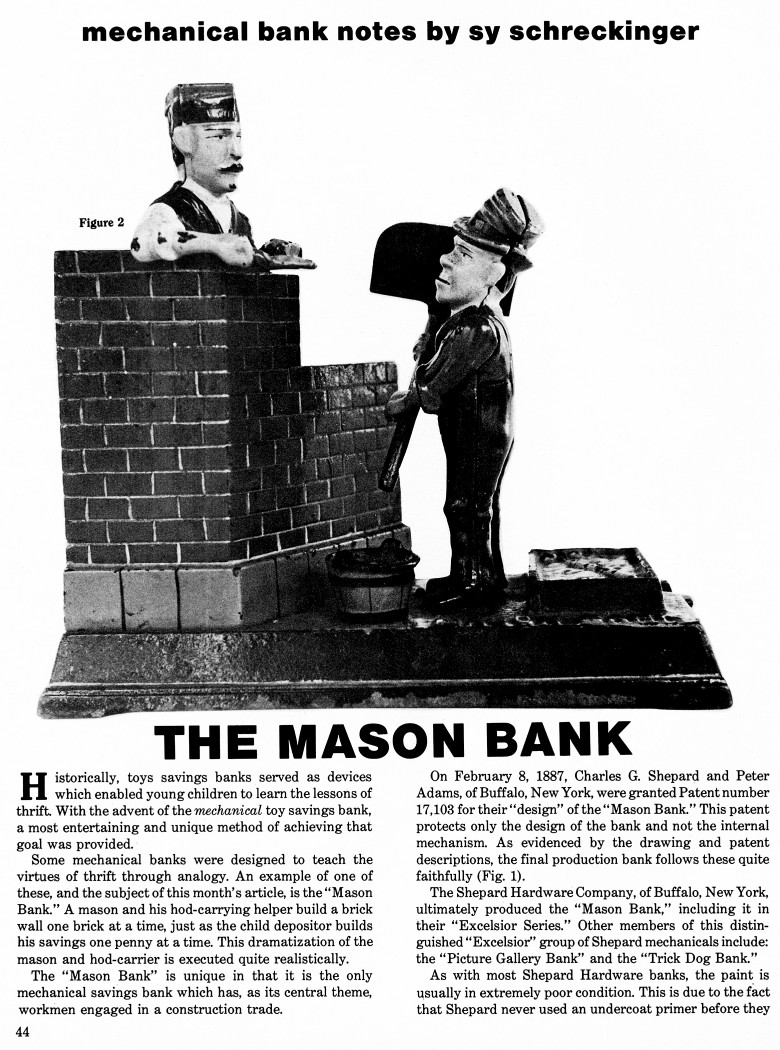|
The Mason Bank
by Sy Schreckinger – ANTIQUE TOY WORLD Magazine – August, 1984
Historically, toys savings banks served as devices which enabled young
children to learn the lessons of thrift. With the advent of the mechanical
toy savings bank, a most entertaining and unique method of achieving that
goal was provided.
Some mechanical banks were designed to teach the virtues of thrift
through analogy. An example of one of these, and the subject of this
month's article, is the "Mason Bank." A mason and his hod-carrying helper
build a brick wall one brick at a time, just as the child depositor builds
his savings one penny at a time. This dramatization of the mason and hod-carrier
is executed quite realistically.
The "Mason Bank" is unique in that it is the only mechanical savings
bank which has, as its central theme, workmen engaged in a construction
trade.
On February 8, 1887, Charles G. Shepard and Peter Adams, of Buffalo,
New York, were granted Patent number
17,103 for their "design" of the
"Mason Bank." This patent protects only the design of the bank and not the
internal mechanism. As evidenced by the drawing and patent descriptions,
the final production bank follows these quite faithfully (Fig. 1).
The Shepard Hardware Company, of Buffalo, New York, ultimately
produced the "Mason Bank," including it in their "Excelsior Series." Other
members of this distinguished "Excelsior" group of Shepard mechanicals
include: the "Picture Gallery Bank" and the "Trick Dog Bank."
As with most Shepard Hardware banks, the paint is usually in
extremely poor condition. This is due to the fact that Shepard never used
an undercoat primer before they painted their banks. Thus, with any degree
of mishandling or adverse atmospheric conditions, the paint would simply
flake off the bank. When one of the Shepard banks is found in unusually
good paint condition, it is often accompanied by a premium price tag.
There are no color or casting variations of the "Mason Bank," and the
colors of the bank pictured in this article (Fig. 2) are: the mason and
the hod-carrier both have pink flesh-colored faces and arms; they have
black eyebrows, white eyes with black pupils, and red mouths. The mason
has a tan hat with a khaki band, black hair and moustache, a white shirt
and a dark blue jacket. His trowel is orange, with light gray cement. The
hod-carrier wears a gray hat with a green band and his hair is brown. He
wears a red shirt, blue pants with green suspenders and black shoes. His
hod has an orange handle and a dark gray scoop filled with light gray
cement. The bucket on the ground is tan with black bands. The top of the
bank's base is gray with the words, "MASON BANK" in gold. The sides of the
base are maroon with a black and gold stripe around the bottom. The brick
wall is red with white mortar lines and its base is dark gray with black
mortar lines. The back of the bank is maroon with the words, "MASON BANK"
in gold.
The combination of fine details, intricate action, multi-coloration,
and unique subject matter make the "Mason Bank" a most highly prized and
sought-after mechanical. Much of its scarcity can be attributed to its
extreme fragility. Thus, when the collector contemplates purchase of a
"Mason Bank," caution should be exercised. Many times, this bank is found
with the following defects: the hod may be broken off or replaced; the
figure of the hod-carrier might be broken off, or repaired at his feet;
one or both of the mason's arms might be missing or replaced; and, because
of the frailty of the paint, as discussed earlier, this bank is quite
often found either touched up or totally repainted.
Once again, I must caution the purchaser of antique mechanical banks
to consult with an expert if he or she is unsure of its authenticity.
The "Mason Bank" has been reproduced; therefore, I am including a
base diagram to illustrate its exact size (Fig. 3). A reproduction will
appear approximately one-eighth inch shorter along the width, due to iron
shrinkage during the casting process.
Correction: Re:
June 1984 issue of Antique Toy World, "The Sportsman
Mechanical Bank." Figure 3, illustrating the base diagram, was placed
upside down. It should read "9 inches" and not 6 inches.
For the past two years, eight persons involved in the field of
mechanical bank collecting, including myself, have been working with Bill
Norman on a Mechanical Bank Encyclopedia. This book contains large, full
color photos of almost every known mechanical bank with related
information. There is also a section of mechanical bank trade cards which
are illustrated in full color.
Appropriately named, The Bank Book by Bill Norman, it is an important
addition to the libraries of both the casual and serious bank collector.
The August issue of Antique Toy World Magazine will contain an order
form, for the book; or, you may write to me: Sy Schreckinger, clo Young &
Rubicam, Inc., 285 Madison Avenue, New York, NY 10017, for additional
information.
Omissions: (from
November, 1996) (1) Operating instructions for the "Mason Bank"
(refer to Antique Toy World,
August 1984) were erroneously omitted: A coin
is placed into the hod and the lever is then pressed. Simultaneously, the
hod tilts forward, the money falls through an opened trap door section
behind the brick wall, and the mason raised his trowel and brick. Deposits
are retrieved by removing the rectangular, key-lock coin retainer
underneath the base.
|


